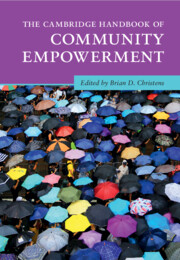Book contents
- The Cambridge Handbook of Community Empowerment
- Cambridge Handbooks in Psychology
- The Cambridge Handbook of Community Empowerment
- Copyright page
- Contents
- Figures
- Tables
- Contributors
- Building Community Power
- Part I Organizing and Activism
- Part II Participatory Governance
- Part III Civil Society and Coalitions
- Part IV Enterprise
- 16 A New Generation of Worker Cooperatives
- 17 Employment Social Enterprises
- Part V Participatory and Community Arts
- Part VI Education and Engaged Research
- Contributor Details
- Index
- References
16 - A New Generation of Worker Cooperatives
from Part IV - Enterprise
Published online by Cambridge University Press: 18 April 2024
- The Cambridge Handbook of Community Empowerment
- Cambridge Handbooks in Psychology
- The Cambridge Handbook of Community Empowerment
- Copyright page
- Contents
- Figures
- Tables
- Contributors
- Building Community Power
- Part I Organizing and Activism
- Part II Participatory Governance
- Part III Civil Society and Coalitions
- Part IV Enterprise
- 16 A New Generation of Worker Cooperatives
- 17 Employment Social Enterprises
- Part V Participatory and Community Arts
- Part VI Education and Engaged Research
- Contributor Details
- Index
- References
Summary
Worker cooperatives – enterprises owned and operated by their employees – offer the potential for workplace socioeconomic empowerment. Historically they have struggled to capture a significant share of employment in the US and to be fully inclusive of communities confronting the greatest social and economic marginalization. Since the Great Recession, however, worker cooperatives have shown strong growth, with increasing representation from BIPOC, working-class, and immigrant communities. This chapter compares two home care worker cooperatives to discuss the benefits that worker cooperatives bring and some of the challenges they face. One, Golden Steps, operates at the small scale typical of most of the newer worker cooperatives, while the other, Cooperative Home Care Associates, is currently the largest worker cooperative in the US. Focusing on the financial, social, diversity, equity, and inclusion (DEI), and labor dimensions of worker cooperatives, we consider the important role of worker ownership and control within broader discussions of individual and community empowerment.
Keywords
- Type
- Chapter
- Information
- The Cambridge Handbook of Community Empowerment , pp. 415 - 437Publisher: Cambridge University PressPrint publication year: 2024



